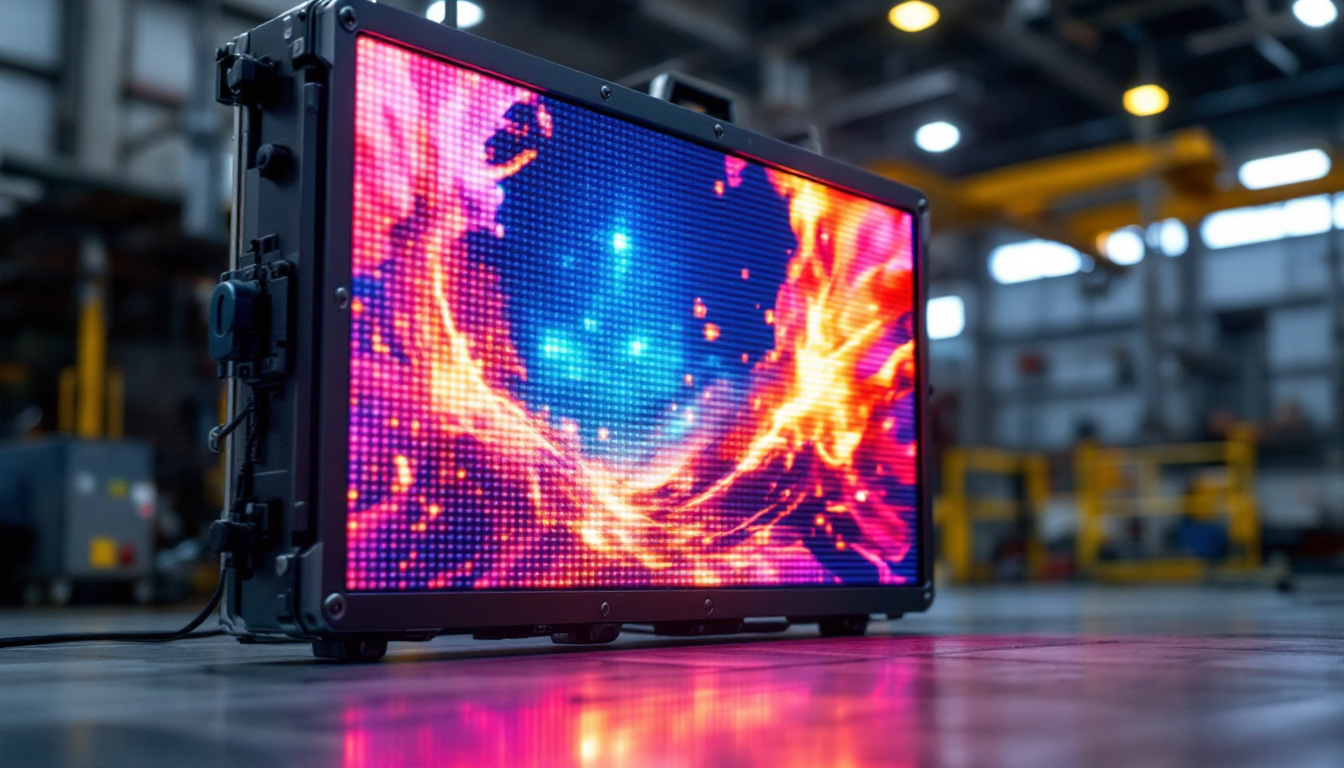In the world of modern display technology, SMD LEDs have emerged as a pivotal component in various applications, from large outdoor billboards to small electronic devices. Understanding what SMD LEDs are and how they function can provide valuable insights into their growing popularity and versatility. This article delves into the intricacies of SMD LEDs, their advantages, applications, and how they compare to traditional LED technologies.
Understanding SMD LEDs
SMD stands for Surface-Mount Device, and SMD LEDs are a type of LED that is mounted directly onto the surface of a circuit board. This method of mounting allows for a compact design, making SMD LEDs an ideal choice for a wide range of electronic devices. Unlike traditional through-hole LEDs, which require holes to be drilled into the circuit board, SMD LEDs are soldered onto the surface, providing a more streamlined and efficient manufacturing process. This efficiency not only reduces production costs but also enhances the overall reliability of the devices, as there are fewer points of potential failure.
Moreover, the compact nature of SMD LEDs enables manufacturers to create smaller and lighter devices, which is particularly beneficial in industries where space is at a premium, such as in mobile phones, wearables, and automotive applications. The ability to fit more components into a limited space without compromising performance has led to innovative designs and functionalities in modern electronics.
How SMD LEDs Work
The operation of SMD LEDs is based on the principles of electroluminescence, where a semiconductor material emits light when an electric current passes through it. In SMD LEDs, the semiconductor chip is encapsulated in a clear resin, which helps to protect it from environmental factors and enhances light output. The design of SMD LEDs allows for multiple chips to be integrated into a single package, enabling a wider range of colors and brightness levels. This versatility is a significant advantage, as it allows designers to create dynamic lighting solutions that can adapt to various settings and requirements.
When power is applied to the SMD LED, electrons recombine with holes in the semiconductor, releasing energy in the form of photons, which is the light that we see. The color of the light emitted depends on the materials used in the semiconductor and the energy bandgap of the material. This relationship between material properties and light emission is what allows for the development of specialized LEDs, such as those that emit ultraviolet or infrared light, expanding their application beyond standard visible lighting.
Types of SMD LEDs
SMD LEDs come in various types, each designed for specific applications. The most common types include:
- Standard SMD LEDs: These are the most widely used and are available in various sizes and colors.
- High-Power SMD LEDs: Designed for applications requiring high brightness, these LEDs can emit significantly more light than standard types.
- RGB SMD LEDs: These LEDs can produce multiple colors by combining red, green, and blue light, making them ideal for displays and decorative lighting.
In addition to these common types, there are also specialized SMD LEDs designed for specific tasks, such as automotive lighting, where they must withstand harsh conditions and vibrations. Furthermore, advancements in technology have led to the development of smart SMD LEDs that can be controlled remotely, allowing for programmable lighting effects and energy-efficient operation. This integration of smart technology into SMD LED design is paving the way for more interactive and customizable lighting solutions in both residential and commercial settings.
Advantages of SMD LEDs
SMD LEDs offer numerous advantages over traditional lighting technologies, making them a preferred choice in many applications. Their compact size, energy efficiency, and versatility are just a few of the reasons for their widespread adoption.
Energy Efficiency
One of the most significant benefits of SMD LEDs is their energy efficiency. They consume significantly less power compared to incandescent and fluorescent bulbs, which translates to lower electricity bills and a reduced carbon footprint. This efficiency is particularly beneficial in large-scale installations, such as outdoor advertising displays, where energy costs can accumulate rapidly. Furthermore, the low heat generation of SMD LEDs means that less energy is wasted as heat, allowing for more effective use of the energy consumed. This characteristic not only enhances their performance but also contributes to a safer environment, reducing the risk of overheating in enclosed spaces.
Compact Design
The compact nature of SMD LEDs allows for more flexible design options. Manufacturers can create thinner and lighter devices without sacrificing performance. This is especially important in the consumer electronics market, where space is often at a premium. The ability to integrate multiple SMD LEDs into a single package also allows for more intricate designs and improved aesthetics. Additionally, their small size enables innovative applications in areas previously deemed impractical for lighting, such as in automotive lighting and wearable technology. Designers can experiment with various configurations and colors, leading to unique lighting solutions that enhance user experience and functionality.
Durability and Longevity
SMD LEDs are known for their durability and long lifespan. Unlike traditional bulbs that may burn out after a certain period, SMD LEDs can last up to 50,000 hours or more, depending on usage and environmental conditions. This longevity reduces the need for frequent replacements, making them a cost-effective option in the long run. Moreover, SMD LEDs are typically resistant to shock and vibration, making them suitable for use in rugged environments where traditional bulbs might fail. This resilience is particularly advantageous in industrial applications and outdoor settings, where exposure to harsh conditions is common. The reduced maintenance requirements not only save money but also minimize downtime, allowing for more efficient operations in both commercial and residential settings.
Applications of SMD LEDs
The versatility of SMD LEDs has led to their adoption in various fields, from consumer electronics to large-scale commercial displays. Here are some notable applications:
Display Technology
SMD LEDs are widely used in display technology, particularly in LED screens for televisions, monitors, and advertising billboards. Their ability to produce bright, vibrant colors and high contrast ratios makes them ideal for creating eye-catching visuals. Additionally, the ability to create flexible and curved displays has opened new avenues for innovative designs.
Automotive Lighting
In the automotive industry, SMD LEDs are increasingly being used for headlights, taillights, and interior lighting. Their compact size allows for more design flexibility in vehicle aesthetics, while their energy efficiency contributes to improved fuel economy. Moreover, SMD LEDs provide better visibility and safety on the road, enhancing the overall driving experience.
Home and Commercial Lighting
From residential lighting fixtures to commercial applications, SMD LEDs have revolutionized how spaces are illuminated. They are used in recessed lighting, track lighting, and even decorative fixtures. Their ability to produce a wide range of colors allows for customizable lighting solutions that can enhance the ambiance of any environment.
Comparing SMD LEDs to Other LED Technologies
While SMD LEDs are popular, they are not the only type of LED technology available. Understanding how they compare to other options can help in making informed decisions for specific applications.
Through-Hole LEDs
Through-hole LEDs are the traditional form of LED technology, characterized by their larger size and the need for holes in the circuit board. While they are easier to handle and replace, they are generally less efficient and take up more space compared to SMD LEDs. Through-hole LEDs are often used in applications where size is not a concern, such as indicator lights on circuit boards.
COB LEDs
Chip-on-Board (COB) LEDs are another type of LED technology that offers high brightness and efficiency. Unlike SMD LEDs, which consist of multiple individual chips, COB LEDs feature several chips mounted directly on a single substrate. This design allows for better thermal management and higher light output. However, SMD LEDs are often preferred for applications requiring more precise control over color and brightness.
Future Trends in SMD LED Technology
The future of SMD LED technology looks promising, with ongoing advancements aimed at improving performance, efficiency, and versatility. As the demand for energy-efficient lighting solutions continues to grow, manufacturers are investing in research and development to create even more innovative products.
Smart Lighting Solutions
One of the most exciting trends in SMD LED technology is the integration of smart features. smart lighting solutions allow users to control their lighting remotely through smartphones or smart home systems. This not only enhances convenience but also contributes to energy savings by allowing users to adjust lighting according to their needs.
Improved Color Rendering
Another area of focus is the improvement of color rendering capabilities. As SMD LEDs evolve, manufacturers are working to enhance the color accuracy and quality of light emitted. This is particularly important in applications such as photography and retail, where accurate color representation is crucial.
Conclusion
SMD LEDs have transformed the landscape of lighting and display technology, offering numerous advantages that make them a preferred choice across various applications. Their energy efficiency, compact design, and durability position them as a leading solution in both consumer and commercial markets. As technology continues to advance, SMD LEDs are likely to play an even more significant role in shaping the future of illumination and display solutions.
Understanding the fundamentals of SMD LEDs and their applications can empower consumers and businesses alike to make informed decisions about their lighting and display needs. With the ongoing innovations in this field, the potential for SMD LEDs is boundless, promising exciting developments in the years to come.
Discover Cutting-Edge LED Displays with LumenMatrix
Ready to elevate your visual experience with the latest in LED display technology? LumenMatrix is at the forefront of innovation, offering a diverse range of LED display modules designed to bring your brand to life. From Indoor and Outdoor LED Walls to specialized solutions like Vehicle Displays and LED Sports Displays, we have everything you need to create immersive and dynamic visual communications. Embrace the future of display technology and check out LumenMatrix LED Display Solutions today to see how we can transform your space and captivate your audience.































